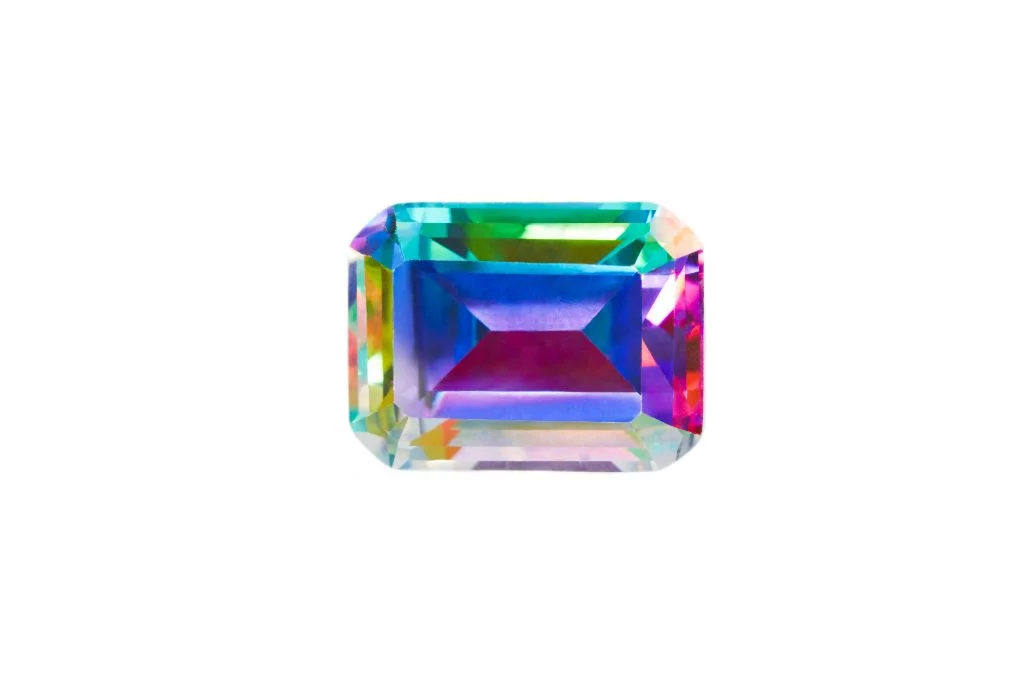Color and Appearance of Azotic Topaz
Azotic Topaz is renowned for its striking and mesmerizing appearance. This gemstone exhibits a vibrant, iridescent rainbow of colors that seem to dance and shift as the stone is moved. The play of colors typically includes hues of blue, green, purple, pink, and gold, creating a captivating visual effect. This unique coloration is not natural but rather the result of a special coating process applied to colorless topaz.
Crystal Structure
As a variety of topaz, Azotic Topaz shares the same crystal structure as its counterparts. It belongs to the orthorhombic crystal system, forming prismatic crystals that are often elongated and striated. The underlying topaz is typically transparent to translucent, allowing the applied coating to create its signature appearance.
Notable Physical Characteristics
Azotic Topaz possesses several noteworthy physical traits. It has a hardness of 8 on the Mohs scale, making it a durable gemstone suitable for various jewelry applications. The crystal exhibits perfect cleavage, which can be a consideration during cutting and setting. Its luster is vitreous, contributing to its overall brilliance when properly cut and polished.
Unique Features
What truly sets Azotic Topaz apart is its distinctive color-changing effect. As light interacts with the thin film coating on the stone’s surface, it creates an interference pattern that produces the iconic rainbow-like appearance. This phenomenon, similar to that seen in soap bubbles or oil slicks, gives Azotic Topaz its mesmerizing allure. The effect is most pronounced when the stone is viewed under different lighting conditions or angles, offering a constantly changing display of colors.
Historical and Cultural Significance of Azotic Topaz
Azotic topaz, while not a naturally occurring gemstone, has gained popularity in recent years due to its striking rainbow-like appearance. This man-made stone is created by coating natural white topaz with a thin layer of titanium, which produces its signature iridescent effect. Although it lacks the historical significance of natural gemstones, azotic topaz has become increasingly valued in modern jewelry design for its unique and eye-catching properties.
Metaphysical Associations
Despite its artificial nature, some metaphysical practitioners attribute various spiritual properties to azotic topaz. It is often associated with enhancing creativity, promoting self-expression, and stimulating imagination. Some believe that the stone’s rainbow-like qualities can help balance and align the chakras, promoting overall energetic harmony within the body. Additionally, azotic topaz is thought to encourage positive thinking and uplift one’s mood, making it a popular choice for those seeking emotional support.
Common Uses and Applications
Azotic topaz is primarily used in jewelry making, where its vibrant colors and sparkle make it a standout choice for statement pieces. It is commonly found in rings, pendants, earrings, and bracelets. The stone’s durability (rating 8 on the Mohs scale) makes it suitable for everyday wear. Beyond jewelry, some people incorporate azotic topaz into meditation practices or carry it as a pocket stone to harness its believed metaphysical properties. In crystal healing, it may be placed on specific body parts to promote energy flow and balance.
Benefits and Modern Applications
Proponents of azotic topaz claim that it can provide various benefits, including boosting confidence, enhancing communication skills, and fostering a sense of wonder and joy. In modern applications, the stone is sometimes used in color therapy, where its rainbow hues are believed to have a positive impact on mood and well-being. Additionally, azotic topaz has found a place in the world of fashion, where designers incorporate it into avant-garde jewelry pieces and accessories to create bold, eye-catching looks that appeal to those seeking unique and colorful adornments.

